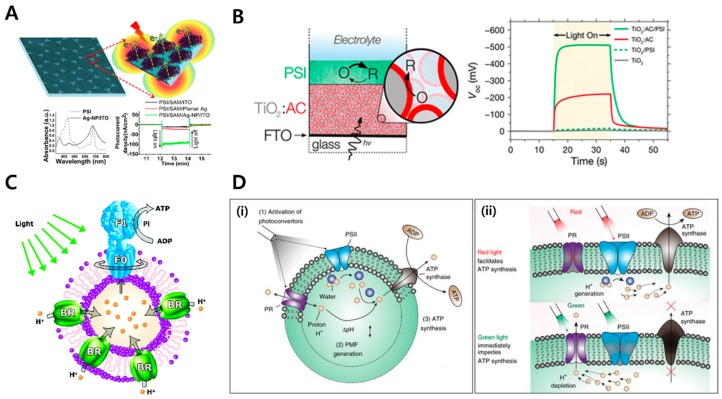Figure 9.
Energy harvesting application of transmembrane proteins. (A) Plasmon-enhanced photocurrent from photosystem I assembled on Ag nanopyramids [17]. With this system, the plasmon-enhanced photocurrents were enhanced up to ~6.5 and ~5.8 compared to PSI assembly on planar Ag substrates for wavelengths of 660 and 470 nm, respectively (Reproduced with permission from Pamu, R. et al. J. Phys. Chem. Lett., 2018. Copyright 2018 American Chemical Society). (B) PSI multilayer film structure and increased photovoltage range [18]. A PSI multilayer film is assembled on a mesoporous film of TiO2 nanoparticles. The PSI multilayer promotes a more than 2-fold increase in photovoltage (Reproduced with permission from Robinson, M. T. et al. ACS Appl. Energy Mater., 2018. Copyright 2018 American Chemical Society.). (C) Schematic representation of the proteopolymersome reconstituted with both bR and F0F1-ATP synthase [19]. When light reaches the bR, the proton transfers from outside to inside the proteopolymersome. Then, the generated proton gradient promotes ATP synthesis by ATP synthase. As a result, ATP is synthesized outside the proteopolymersome (Reproduced with permission from Choi and Montemagno, Nano Lett., 2005. Copyright 2005 American Chemical Society). (D) Design and applications of the artificial photosynthetic organelle [20]. Using PR and PSII, ATP synthesis is controlled by different wavelengths of light. Red light facilitates ATP synthesis, while green light impedes ATP synthesis (Reproduced with permission from Lee, K. Y. et al. Nat. Biotechnol., 2018. Copyright 2018 Springer Nature.).

